On Working and Labor Day 2017
Although the campus is buzzing with the excitement of football — first home game tonight — and the beginning of classes next week, we want to take this occasion to honor Labor Day (September 4, 2017) with titles on working and labor from our holdings.
Our Little Magazines collection includes issues of such titles as Workers Write:
From our 20th Century authors collection, a pamphlet recounting a debate between George Bernard Shaw and Mr. G.W. Foote over the 8-hour work day (London, 1891):

and a slim work by Sinclair Lewis published by the United Textile Workers of America and Women’s Trade Union League.
The Cairns Collection of American Women Writers contains many titles about the labor of women and children — among them,



And, for a different take on work as a concept in physics (defined by the Oxford English Dictionary as “The operation of a force in producing movement or other physical change, esp. as a measurable quantity; the result of a force operating through a distance”), an illustration from the tradition of “theaters of machines”

and examples of mechanical work from a 19th-century collection illustrating ideas and experiments in natural philosophy.






